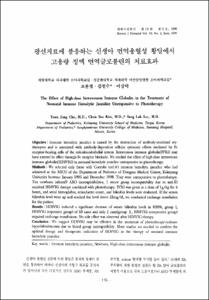광선치료에 불응하는 신생아 면역용혈성 황달에서 고용량 정맥 면역글로불린의 치료효과
- Keimyung Author(s)
- Kim, Chun Soo; Lee, Sang Lak
- Department
- Dept. of Pediatrics (소아청소년학)
- Journal Title
- 대한주산의학회잡지
- Issued Date
- 1999
- Volume
- 10
- Issue
- 2
- Keyword
- Immune hemolytic jaundice; Newborn; High-dose intravenous immune globulin; 신생아면역용혈성황달; 고용량정맥면역글로불린
- Abstract
- Objective : Immune hemolytic jaundice is caused by the destruction of antibody-sensitized erythrocytes and is associated with antibody-dependent cellular cytotoxic effects mediated by Fc receptor-bearing cells of the reticuloendothelial system. Intravenous immune globulin(IVIG) may have exerted its effect through Fc receptor blockade. We studied the effect of high-dose intravenous immune globulin(HDIVIG) in neonatal hemolytic jaundice unresponsive to phototherapy.
Methods : We selected only those with Coombs test(+) immune hemolytic jaundice who had admitted at the NICU of the Department of Pediatrics of Dongsan Medical Center, Keimyung University between January 1995 and December 1998. They were unresponsive to phototherapy. Ten newborn infants(9 ABO incomplatibilities, 1 minor group incompatability due to anti-E) received HDIVIG therapy combined with phototherapy. IVIG was given as a dose of 1g/㎏ for 6 hours, and serial hemoglobin, reticulocyte count, and bilirubin levels were evaluated. If the serum bilirubin level went up and reached the level above 22㎎/㎗, we conducted exchange transfusion for the patient.
Results : HDIVIG induced a significant decrease of serum bilirubin levels in 8(80%, group Ⅰ, HDIVIG responsive group) of 10 cases and only 2 cases(group Ⅱ, HDIVIG unresponsive group) required exchange transfusions. No side effect was observed after HDIVIG therapy.
Conclusion : We suggest HDIVIG may be effective in the treatment of phototherapy-resistant hyperbilirubinemia due to blood group incompatibility. More studies are needed to confirm the optimal dosage and therapeutic indication of HDIVIG in the therapy of neonatal immune hemolytic jaundice.
목적 : 광선치료에 불응하는 Coombs test 양성인 신생아 면역용혈성 황달 환아에게서 고용량 정맥 면역 글로불린의 치료 효과를 알아보고자 한다.
연구 방법 : 1995년 1월부터 1998년 12월까지 만 4년간 계명대학교 동산의료원에서 신생아 면역용혈성 황달로 치료를 받았던 환아 중 23례에서 광선 치료만으로 호전된 경우 7례와 입원당시 혈중 빌리루빈치가 높아 바로 교환수혈을 하였던 6례를 제외한 10례를 대상으로 하였다. 이들은 입원후 광선치료에도 불구하고 빌리루빈치가 증가하여 생후 24시간내 15㎎/㎗, 생후 24시간 이후 20㎎/㎗까지 증가한 경우이었다. 대상 환아에게 면역 글로불린을 체중 1㎏당 1g 용량으로 6시간에 걸쳐 천천히 정맥으로 1회 투여하였으며, 광선치료와 IVIG 치료 후에도 지속적으로 빌리루빈치가 증가하여 혈중 빌리루빈치가 22㎎/㎗ 이상시 교환수혈을 시행하였다. 10례중 광선치료와 HDIVIG으로만 치료가 된 군을 Ⅰ군, 광선치료와 HDIVIG을 사용하고도 교환 수혈이 필요했던 군을 Ⅱ군으로 두어 양군간에 황달 출현 시기, 지속기간, 입원당시와 입원동안의 최저 혈색소, 최고 망상적혈구 수, 최고 빌리루빈치, 입원일수를 비교분석 하였다. 이들 군간의 통계처리는 SPSS의 two-sample Kolmogorov-Smirnov test를 이용하여 p<0.05를 의미 있는 것으로 하였다.
결과 :
1) 10례중 Ⅰ군은 8례, Ⅱ군은 2례로, 평균 임신기간, 출생체중, 평균 입원시 연령은 두군간에 차이가 없었다. Ⅰ군 중 7례는 ABO부적합이었고, 1례는 minor 혈액형 부적합(anti-E)이었으며 Ⅱ군은 2례 모두 BO부적합 이었고, 황달의 출현 시기는 Ⅰ, Ⅱ군 모두 생후 24시간 이내였다.
2) 양군간 입원당시 혈색소, 빌리루빈치는 유의한 차이가 없었으며, 입원기간동안 최저 혈색소, 최고 망상적혈구수, 최고 빌리루빈치도 차이가 없었고 최고 혈중 빌리루빈치는 Ⅱ군에서 Ⅰ군보다 높았으나 유의한 차이는 없었다. HDIVIG 투여시 평균 연령은 Ⅰ군 2.5일, Ⅱ군 3.4일이었고. 입원일수는 Ⅰ군 8.5±3.0일, Ⅱ군 10.0±5.6일로 유의한 차이는 없었다.
3) 치료후 합병증은 발견되지 않았다.
결론 : 광선치료에 불응하는 신생아 면역용혈성 환자들에게 교환수혈 수치에 이르기 전에 IVIG의 치료를 하는 것이 별 부작용 없이 교환수혈의 빈도를 줄일 수 있다고 생각되며, 이후로도 IVIG의 적정 투여 용량과 사용 기준에 대한 좀더 많은 연구가 있어야 되겠다.
- Alternative Title
- The Effect of High-dose Intravenous Immune Globulin in the Treatment of Neonatal Immune Hemolytic Jaundice Unresponsive to Phototherapy
- Publisher
- School of Medicine
- Citation
- 조윤정 et al. (1999). 광선치료에 불응하는 신생아 면역용혈성 황달에서 고용량 정맥 면역글로불린의 치료효과. 대한주산의학회잡지, 10(2), 176–182.
- Type
- Article
- ISSN
- 1229-2605
- Appears in Collections:
- 1. School of Medicine (의과대학) > Dept. of Pediatrics (소아청소년학)
- 파일 목록
-
-
Download
 oak-bbb-3608.pdf
기타 데이터 / 1.38 MB / Adobe PDF
oak-bbb-3608.pdf
기타 데이터 / 1.38 MB / Adobe PDF
-
Items in Repository are protected by copyright, with all rights reserved, unless otherwise indicated.